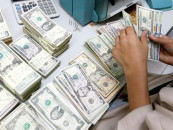Pakistan's reliance on US for forex inflows
Pakistan cannot afford to create any problem to disturb flow of foreign exchange

Despite a growing economic relationship with Beijing and the largesse received in the recent past from China as well as Saudi Arabia and the United Arab Emirates (UAE), Pakistan’s external sector health remains tied largely with its relationship with the US. There is no secret about it.
It is important to look at how the US, the mightiest economy of the world, continues to help Pakistan shape up its economy, in general, and the external sector, in particular.
In the external sector, the US is important for Islamabad in terms of being the largest export market, the third most valuable centre for the flow of remittances, and a sizable foreign and portfolio investor.
However, in the post-Covid-19 pandemic world, each area is vulnerable to shock. That is why we see Islamabad treading so cautiously in geopolitics.
The country cannot afford to add any home-made reason to disturb the flow of foreign exchange from the US on top of the reasons beyond its control eg the US and global recession post-pandemic.
Exports have traditionally remained the biggest source of foreign exchange inflow from the US, though for some years remittances have come closer to exports. But just as Pakistan has miserably failed to boost its overall merchandise exports in the past decade, it has also failed to export more to the US.
In fact, after hitting a high of $4.1 billion back in FY11, Pakistan has never been able to come closer to that mark in the past nine years.
Pakistan’s exports to the US have always grown more on trade concessions and less due to diversification of export products or deeper penetration into the US market by the exporters. That is the number one problem.
Another problem is that Pakistan’s exports to the largest economy of the world mostly comprise textile items, food products, surgical and sports goods, carpets and flooring items.
Even within the broad category of textile, the exports to the US are concentrated in a few sub-categories like cotton yarn, men and women wear, bed wear and towels. In food items, major foreign exchange earners remain limited to various varieties of rice, and fish and fish preparations.
The same limitations can be seen in the list of surgical and sport goods, carpets, etc on closer scrutiny.
Obviously, there is a need to expand the scope of exports to the US market with all or most items of a broad category and to make that happen the government and exporters need to work out a sustainable strategy.
Besides, Pakistan’s exports to the US go mostly to bulk buyers that offer lower prices rather than to big chains of retailers that can and do offer better prices. That requires intense marketing by the exporters with the help of government and consulates there.
Remittances
The US is Pakistan’s third key source of workers’ remittances after Saudi Arabia and the UAE. With the temporary ban on the import of manpower, the US has practically closed all doors for giving a boost to remittances by way of exporting more manpower.
We will have to contend with what Pakistanis already living and working there can send back home during these recessionary times. We should not forget that joblessness in the US continues to grow amid the spread of Covid-19 and the International Monetary Fund (IMF) has predicted a 5% recession in 2020 for the largest economy of the world.
In July-May FY20, remittances from the US stood at $3.71 billion or 18% of the total of $20.65 billion, State Bank data reveals.
How Islamabad can manage to attract this much remittances from the US in the current fiscal year is a troubling question for the economic policymakers to focus on. They must find out an out-of-the-box solution to the issue.
Foreign investment
The most uncertain source of foreign exchange flow from the US is foreign investment. As Islamabad and Beijing continue to achieve new milestones of economic cooperation under the China-Pakistan Economic Corridor (CPEC), Washington keeps expressing its reservations – often in public.
Whereas its reservations are addressed behind closed-door meetings, the non-political dynamics of foreign investment coming from the US always remain open for public debate and policy analysis.
Even before Covid-19 hit the world, American corporate investors were a little bit shy of investing in Pakistan, though portfolio investment continued to come in a big way – thanks to very lucrative yields on government debt securities.
However, those yields are gone after the recent 625-basis-point cut in the State Bank of Pakistan’s key policy rate.
American investors have their own, new-found worries in the post-pandemic world and they would naturally make investment risk projections in line with the changing global economic dynamics.
In our case, they would also likely take into account the military conflict between China and India in which Pakistan can be dragged. So, in the area of foreign investment, Pakistan cannot expect much from the US in the new fiscal year or even in coming few years.
In July-May FY20, Pakistan managed to attract a total of $2.40 billion in foreign direct investment on a net basis. Out of that, only about $90 million came from the US.
In the same period, the country rather saw a net outflow of foreign portfolio investment of about $528 million including $117 million of the US.
The writer is a mechanical engineer and is doing masters
Published in The Express Tribune, July 20th, 2020.
Like Business on Facebook, follow @TribuneBiz on Twitter to stay informed and join in the conversation.



















COMMENTS
Comments are moderated and generally will be posted if they are on-topic and not abusive.
For more information, please see our Comments FAQ